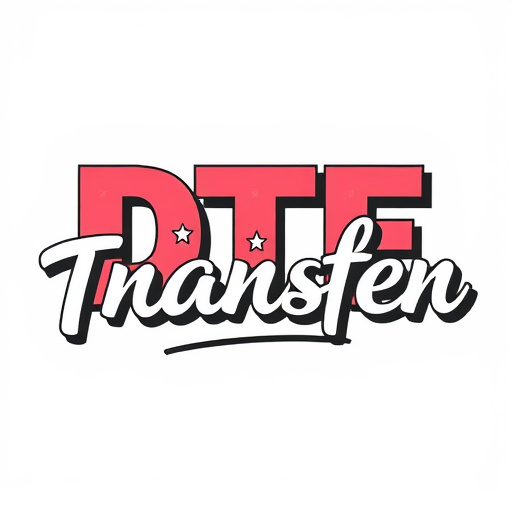Direct-to-Film (DTF) transfers revolutionize printing by directly applying high-quality designs onto materials like polyester and vinyl, transforming industries from retail to fashion and home decor. Key steps include selecting appropriate film and paper for durability and vibrancy, properly preparing surfaces, and accurately calibrating colors during the transfer process. Post-processing involves enhancements and curing to ensure long-lasting prints suitable for diverse applications. Avoiding common mistakes, such as using low-resolution art or incorrect exposure, yields crisp, vibrant DTF prints true to the original digital design.
“Unleash the power of direct-to-film (DTF) transfers and elevate your printing game! This comprehensive guide offers invaluable insights into the world of DTF, a versatile technique for achieving stunning visual effects. From understanding the fundamentals to mastering application methods, we’ll walk you through each step. Learn how to choose the perfect film and paper combinations, prepare surfaces for optimal results, and avoid common pitfalls. Discover the art of DTF printing, where precision meets creativity, and create unforgettable DTF prints.”
- Understanding Direct-to-Film Transfers (DTF) and Their Applications
- Choosing the Right Film and Paper for DTF Printing
- Pre-Treatment of Surfaces: Preparing Your Canvas for DTF Transfer
- Techniques for Applying DTF: Step-by-Step Guide
- Post-Processing: Enhancing and Curing DTF Prints
- Common Mistakes to Avoid in Direct-to-Film Transfers
Understanding Direct-to-Film Transfers (DTF) and Their Applications

Direct-to-Film Transfers (DTF) represent a cutting-edge technology that facilitates the creation of high-quality prints directly on various film materials, such as polyester or vinyl. This innovative process has gained significant traction across diverse sectors, including signage, decorations, and even artistic applications. DTF transfers offer a unique advantage by enabling intricate designs with vibrant colors and crisp details to be seamlessly imprinted onto a wide range of surfaces, from clothing to walls and furniture.
The versatility of DTF makes it suitable for various scenarios. For instance, in the retail industry, DTF printing is utilized for creating eye-catching window displays and promotional materials. In the fashion sector, designers leverage DTF transfers to adorn garments with custom graphics and patterns, allowing for personalized and trendy clothing options. Moreover, DTF technologies have found a niche in home decor, enabling individuals to transform their living spaces with unique, customizable artwork and murals.
Choosing the Right Film and Paper for DTF Printing

When it comes to achieving high-quality results with direct-to-film (DTF) transfers, selecting the appropriate film and paper is a key step. The choice should be guided by the specific requirements of your project, including the desired print quality, color accuracy, and longevity. High-resolution films designed for DTF printing offer exceptional detail replication, ensuring that every element of your design, from fine lines to subtle textures, translates accurately onto the final print.
Consider factors like film type (e.g., vinyl, polyester), thickness, and adhesive properties, as well as paper selection, which impacts print durability and color vibrancy. For outdoor applications or environments with varying weather conditions, choose films with UV protection to prevent fading and ensure your DTF prints remain vibrant over time. Corresponding paper options should offer resistance to moisture, abrasions, and environmental factors to maintain the integrity of the printed image.
Pre-Treatment of Surfaces: Preparing Your Canvas for DTF Transfer

Before applying a direct-to-film (DTF) transfer, proper surface preparation is crucial to ensure optimal print quality. The first step involves cleaning the substrate thoroughly to remove any dirt, grease, or contaminants that might interfere with the adhesion of the film. This can be achieved through a simple process of washing and drying, ensuring the surface is free from debris.
Additionally, priming the surface may enhance the DTF Printing process. A thin layer of primer can fill minor imperfections, creating a smooth canvas for the transfer. This step is particularly important when working with rougher materials to guarantee a crisp and precise print. By addressing these preparation aspects, you’re setting the stage for vibrant and long-lasting DTF prints.
Techniques for Applying DTF: Step-by-Step Guide

Applying Direct-to-Film (DTF) transfers involves a precise process to ensure optimal results. Here’s a step-by-step guide:
1. Prepare Your Surface: Begin by cleaning and preparing your desired substrate, whether it’s fabric, wood, or metal. Ensure the surface is free of dust, grease, or any contaminants that could interfere with adhesion. A smooth, clean surface is crucial for high-quality DTF prints.
2. Choose the Right Film and Ink: Select a DTF transfer film suitable for your material type. Different films offer varying levels of durability and opacity. Pair this with compatible ink designed for direct printing on the chosen film. The quality of your print heavily relies on using the right materials from the start.
3. Design and Print Your Image: Create or source an image you wish to transfer. Using vector graphics or high-resolution raster images ensures better results. Print the image directly onto the DTF film using a compatible printer, adhering to the manufacturer’s guidelines for settings and ink types.
4. Pre-heat and Apply Pressure: Pre-heat your substrate to match the recommended temperature for the specific DTF film. Once heated, carefully apply the film, ensuring no air bubbles are trapped between the print and the surface. Use a pressure applicator or a hot press for even application, pressing firmly but gently to avoid damage.
5. Cure and Post-Process: After applying the transfer, cure it according to the film manufacturer’s instructions. This step ensures long-lasting durability. Finally, clean the surface and your equipment, removing any residual ink or debris.
Post-Processing: Enhancing and Curing DTF Prints

After applying a direct-to-film (DTF) transfer, the post-processing phase is crucial for achieving high-quality DTF prints. This step involves enhancing and curing the printed film to ensure optimal performance when used with various printing techniques. The first part of this process is enhancement, where specific chemical treatments are applied to improve the print’s durability, color vibrancy, and overall image quality. These treatments can include coating the film with protective layers or adding light-sensitive components that react during exposure, resulting in sharper details and more vibrant colors.
Curing is the subsequent vital step, where the DTF prints are exposed to specific conditions, typically UV light, to set the ink and ensure long-lasting stability. This process eliminates any residual moisture or volatile organic compounds (VOCs), preventing smudging or fading over time. Proper curing also ensures that the print adheres well to various substrates, making it suitable for a range of applications, from signage to art prints and even specialized industrial uses.
Common Mistakes to Avoid in Direct-to-Film Transfers

Direct-to-film (DTF) transfers are a popular method for creating high-quality prints, but many users fall into common pitfalls that can negatively impact their final products. One of the primary mistakes to avoid is using low-resolution or poorly prepared source files. DTF transfers rely on intricate detail and sharp edges, so ensuring your digital art meets these standards is paramount. Avoid pixelation and blurriness by utilizing high-resolution images (300 DPI or higher) and carefully optimizing the file for printing.
Another frequent error involves improper color calibration. Inaccurate color representation can result in prints that lack vibrancy and saturation. Always profile your monitor to match your print environment, and consider using industry-standard color profiles to ensure consistent and accurate colors across different devices. Additionally, over-saturating or under-exposing the film during the transfer process can lead to unwanted artifacts and loss of detail, so meticulous adjustments are crucial to achieving crisp and true-to-life DTF prints.














